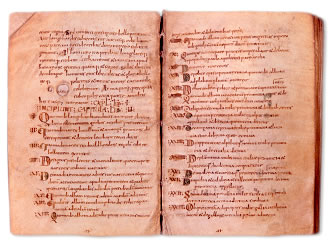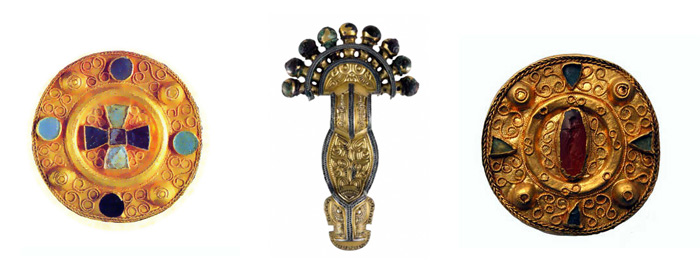To know
“LONGOBARD” identity
The scientific debate as to the ethnic identification of the "Longobard people is still open. This debate thrives, particularly, on the uncertainty of attribution to the "Longobards" of finds regarding material culture, funerary uses and customs, and artistic expressions, rather than to other contemporary peoples who participated with them in the epic migration from the seas of the North to the southern shores of Italy, such as the Cherusci, Marcomanni, Thuringians, Saxons, Swabians, Gepids, Rugii, Herules, and also the Sarmatians, Bulgarians and various Slav groups.
We must therefore make it clear that the term “Longobard” could mean, primarily, the human group belonging to an original tribal nucleus (the mythical Scandinavian tribe of the Winnili) from which a dominant ruling class evolved. A leading tribe for cohesion and fighting skill, as well as for its deep-rooted social and religious traditions following the cult of Odin.
Levels of the Root
Due to the nature, complexity and diversification of the history and cultural development of the Gens Langobardorum, the structure of the Route is therefore based on three levels, all distinct from one another but closely interdependent: the historic and cultural level, the geographical level and the organizational level.
- Historic and cultural level: this concerns the whole development cycle of Longobard culture in the historically ascertained phases of the great migration, from Northern Europe (area of the first migration from the mythical Scandinavian lands) to Central Europe and from there to Italy;
- Geographical level: this concerns the physical nature and the environmental characteristics of the territories in the European geocultural corridor within which the route is traced, with specific attention to their use and functions under the Longobards;
- Organizational level: this consists of the directions taken by the “Longobardia System”, drawn up by the proposing Association to promote the influx of sustainable and responsible tourism together with the development of the individual territories through which the Route passes, preserving and enhancing their particular features and specific identities.
Corresponding to these levels there is a decreasing dimensional scale in the territorial articulation of the Route: European, multinational, national, local.

Three types of Criteria were identified and adopted:
- a) GENERAL
- b) THEMATIC
- c) SYSTEM
a) GENERAL CRITERIA (cultural level)
These criteria define the significance of the title of the Route in the two meanings of the term "Way":
1 - WAY as "path" - In this sense of the term the Route exploits and promotes, for purposes of tourism and culture, Territories and places coinciding with the journey made by the Longobards - over a period of 1200 years - along the ““European geocultural corridor” that extended from the seas of the North to the Mediterranean.
2 - WAY as a "way of being" - In this sense of the term the Route exploits and promotes the knowledge of the evolutionary phases of Longobard Culture from the early days of its history to its peak, represented by the formation of a prime root of European Culture, by the opening to a new Mediterranean culture, and by its nature as a successful Early Medieval example of the phenomenon of migration and integration.
b) THEMATIC CRITERIA (geographical level)
They are the basis for the development of the main elements which, in the context of the Route, characterize the ensemble of Longobard History and Culture.
3 - Territory, Nature, Historic landscapes - through ancestral routes and Roman roads, but also modern highways of interest for tourism in all its articulations, the route allows, also through its place names, the knowledge of the functions assigned to the Territories in the Longobard period and of the changes that occurred in the landscape, and stimulates a potential for interest and development based on the reinterpretation of natural equilibriums, of the bonds between urban centres and rural centres.
4- Settlement areas, necropoles and centres of power - In its articulations and territorial diversifications, the Route combines places where Longobard presence is confirmed by areas of settlement - necropoles, towns and villages, centres of power (royal towns, duchies, gastaldati), structures with functions of defence and control.
5- Places of worship, monasteries and sanctuaries - The Route - especially in Italy - links places of worship, monasteries and sanctuaries built or supported by the Longobard aristocracy: all important points for the diffusion of the faith, the safeguarding of texts from classical culture, and for having been points of reference (still active) for the later medieval phenomenon of pilgrimages which allowed "an intense interchange of values and the development of a sense of unity among various Peoples".
6 - Material culture and arts -The Route identifies the guidelines for using the artistic and cultural paths which can be divided into physical paths and purely cultural paths. These are: the elements of material culture (Itineraries for getting to know museum items in relation to their periods, styles and areas of influence); artistic and architectural elements, starting from the UNESCO serial site “The Longobards in Italy. The centres of power (568-774 A.D.)”; the elements of figurative arts

c) SYSTEM CRITERIA (organizational level)
They define the organizational articulation of the Route in the Territories through which it passes and the method of integrated promotion of quality resources and excellent features of interest for tourism:
7 - Macro-areas - The articulation of the European Route is based on four European macro-areas, each corresponding to specific phases in the development of Longobard civilization: the North European phase defined “Lands of the Elbe”; the Central European phase defined “Lands of the Kings“; the Italian phase defined “Lands of the Kingdom”; the Mediterranean phase defined “Lands of the Princes“.
8 - Tourism Clusters - Each macro-area of the Route is subdivided into tourism clusters, that is into territories characterized by particular historic and environmental features referring to the presence of the Longobards and in which, alongside the basic cultural path, there are also minor territorial areas (municipal areas) with their respective resources of interest for tourism (other cultural lines, excellent products in the sectors of wines and gastronomy, handicrafts, etc).
News
-
2025 24 SeptemberTra le carte della Corona
-
2025 24 SeptemberLa religiosità dei Longobardi
-
2025 21 MarchERRATA CORRIGE CONVEGNO DONNE LONGOBARDE
